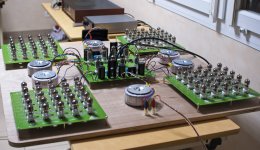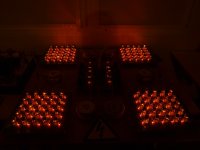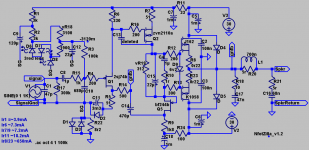SWF, why not try degeneration in the input Jfet rather than the VAS? I was thinking this might have a minimal impact on the sound compared to a degenerated VAS. There are still so many things to try with this amp.
- keantoken
- keantoken
Kean,
I have been there and tried this, probably a few months back now! The problem I have found is that the jfet is a very low gain device and too much degeneration killed the liveliness. I would like to use even less degeneration for the jfet but then you start needing massive shunt feedback caps to maintain LF performance.
Again, this has been my finding and your personal tastes may disagree entirely. Do try it and let me know!
There is no doubt that with compensation the amp is very well behaved and perhaps has what some might call a "sophisticated" sound. It does everything and you can't really fault its reproduction. However, it appears I prefer liveliness over sophistication!
I have been there and tried this, probably a few months back now! The problem I have found is that the jfet is a very low gain device and too much degeneration killed the liveliness. I would like to use even less degeneration for the jfet but then you start needing massive shunt feedback caps to maintain LF performance.
Again, this has been my finding and your personal tastes may disagree entirely. Do try it and let me know!
There is no doubt that with compensation the amp is very well behaved and perhaps has what some might call a "sophisticated" sound. It does everything and you can't really fault its reproduction. However, it appears I prefer liveliness over sophistication!
Well I think if music is supposed to tap your foot, and it doesn't when played through a system, the system must be flawed somehow.
To be honest I don't have much experience messing with degeneration and the like. I now that there are some "sweet spots" which can give certain unique qualities to the treble, but I wasn't impressed usually. I pretty much agree with you anywhere you say it "removes the liveliness". What we really want I'm sure is a good combination of liveliness AND sophistication. In experience with my headamp, when these two are both had in the appropriate amounts, the sound becomes incredibly realistic. It is really amazing, and hard to describe.
- keantoken
To be honest I don't have much experience messing with degeneration and the like. I now that there are some "sweet spots" which can give certain unique qualities to the treble, but I wasn't impressed usually. I pretty much agree with you anywhere you say it "removes the liveliness". What we really want I'm sure is a good combination of liveliness AND sophistication. In experience with my headamp, when these two are both had in the appropriate amounts, the sound becomes incredibly realistic. It is really amazing, and hard to describe.
- keantoken
I have to say, my speakers are very flat and rarely sound good, so it is possible I am looking for some artificial life for my music by using an amplifier that is slightly unstable.
As long as I can get away with it in my final listening position I will be using no compensation. I will try some stability tests with 3m leads tonight.
This is what Naim amplifiers have been famous for in the UK for years. They advise you not to use high capacitance cables because it can affect stability.
So if you choose your cables carefully I think you will be OK. 3 meters is not that long.
Otherwise, as you have not built your boxes yet, you could just go for mono-block amps and place them next to the speakers.
However, I suspect that with speaker leads attached, if necessary, you could just re-tune the compensation to give the amps the degree of "excitement" that you like the sound of.
The bottom line is it's your hi-fi and you can do whatever you want with it.
Personally I think that the energy sapping effect of "conventional" compensation is just as "unnatural" as the slightly unrefined sound that comes from having too much instability but as I mentioned many posts ago, us DIYers have the luxury of being able to "tune" our amps to exactly match whatever leads / speakers we happen to have to achieve a really optimised sound.
Manufacturers do not have this degree of flexibility available to them. Their amps have to be stable into any load which means that for some loads the amps will not be realising their full "foot tapping" potential !
I'm really looking forward to experimenting with this stuff fairly soon.
cheers
mike
Last edited:
One last tip - I have found that EI transformers sound much better that torroids.
I'm saying this the last 20 years. Toroids are maybe good for harsh sounding semicon amps but normally they do sound wooly, slow & thick. They are a no go for tube amps.
Which is kind of odd, because it seems like 95% + of manufacturers use them.
perhaps they never did a comparison
p.s. not all semicon amps sound harsh 🙂
perhaps they never did a comparison
p.s. not all semicon amps sound harsh 🙂
Chasing liveliness and sophistication...
All,
Here's an idea.
I wonder if the reduction in "liveliness" caused by compensation in the vas and inout stage can be offset by using vertical output fets (which have a much higher transconductance than the laterals we're using)?
I tried vertical fets in this circuit once and thought they sounded harsh (maybe "lively" gone too far!), but I never tried them in a circuit with compensation!
I've got a sneaky suspicion this might just work...
All,
Here's an idea.
I wonder if the reduction in "liveliness" caused by compensation in the vas and inout stage can be offset by using vertical output fets (which have a much higher transconductance than the laterals we're using)?
I tried vertical fets in this circuit once and thought they sounded harsh (maybe "lively" gone too far!), but I never tried them in a circuit with compensation!
I've got a sneaky suspicion this might just work...
I'm saying this the last 20 years. Toroids are maybe good for harsh sounding semicon amps but normally they do sound wooly, slow & thick. They are a no go for tube amps.
The shape is not enough to define quality. Magnetic material, winding, insulation all is more important then shape.
If you need air gap as output transformer for SE tube amp then toroid out.
dado
I've got a sneaky suspicion this might just work...
Mmmmm, well possibly, but my guess is not.
I don't want to sound like the voice of doom before you begin but OLG is OLG no matter what elements contribute to what degree to it.
I have the feeling that you might enjoy the sound of big efficient speakers. Some people say that 100db / watt / at 1 meter speakers have dynamics that cannot be matched by anything else. Personally I find my 90db speaker quite reasonable in the dynamics department.
With the amp, my approach is to reduce PSU noise to lowest possible levels so I need not rely upon High FB & high PSRR to achieve low noise. Then I can reduce the feedback levels without incurring a penalty in the noise department and then hopefully I can get speed, dynamics & refinement.
I'll know if I succeeded in this endeavour in a few weeks.
Last edited:
They are a no go for tube amps.
Some seem to disagree with you (for a lot longer than 20)
Standard issue toroidals as OT's=>
Attachments
Last edited:
p.s. The classic dynamics + refinement combination is 100db speakers with a well designed single ended triode, zero feedback, valve amp.
If I didn't dislike the sound of caps & transformers I would be quite tempted by this myself.
My goal for the last few years is to achieve these goals with solid state which is why I was so excited when I came across this design.
If I didn't dislike the sound of caps & transformers I would be quite tempted by this myself.
My goal for the last few years is to achieve these goals with solid state which is why I was so excited when I came across this design.
Last edited:
SWF,
Don't be too wedded to liveliness. You often find such amps have a lot of ringing on a 1KHz square wave - not saying this of the Fetzilla but it's possible - and the 'zinginess' is actually short term instability, cf. ringing, which you like.
Often sins and misdemeanours have their own appeal with audio amps.
I would be taking a compromise course, and using about 30pF lag compensation, and trying around 47pF of phase lead as well. You might have less lively sound, but then this might be an artefact, something not actually on the recording.
I always use piano, female vocal and violin to gauge these qualities.
I disagree about toroids. Their problem is not that they are slow and leaden at all, it's that they pass HF mains disturbances far too well. BUT, the transformer becomes much less important if you clean up the rails with CRC, or better still CLC, filtering.
The Fetzilla, being single ended to the output stage, does NOT have a good PSRR, so a quiet supply is indeed necessary, and made the more important by a high quiescent current which really brings out the ripple.
Jacco,
Please stop posting audio porn. It's having a very bad effect on my ageing mind.....
Cheers,
Hugh
Don't be too wedded to liveliness. You often find such amps have a lot of ringing on a 1KHz square wave - not saying this of the Fetzilla but it's possible - and the 'zinginess' is actually short term instability, cf. ringing, which you like.
Often sins and misdemeanours have their own appeal with audio amps.
I would be taking a compromise course, and using about 30pF lag compensation, and trying around 47pF of phase lead as well. You might have less lively sound, but then this might be an artefact, something not actually on the recording.
I always use piano, female vocal and violin to gauge these qualities.
I disagree about toroids. Their problem is not that they are slow and leaden at all, it's that they pass HF mains disturbances far too well. BUT, the transformer becomes much less important if you clean up the rails with CRC, or better still CLC, filtering.
The Fetzilla, being single ended to the output stage, does NOT have a good PSRR, so a quiet supply is indeed necessary, and made the more important by a high quiescent current which really brings out the ripple.
Jacco,
Please stop posting audio porn. It's having a very bad effect on my ageing mind.....
Cheers,
Hugh
Last edited:
Some seem to disagree with you (for a lot longer than 20)
Standard issue toroidals as OT's=>
hi jacco,
Yes, standard toroids will work as o/p transformers, they can have a reasonably flat response up to around 20khz, but they do not perform as well a specially designed o/p transformer and they can only be used in push pull designs because they cannot tolerate DC.
But it is precisely because they have a reasonably good frequency response that they are not so ideal as power supply transformers.
I was using torroids and decided to just try very similar spec EI's before I added full choke regulation.
I was expecting a small difference but I got a big surprise. It was like night & day - much more musical sound and less background grunge.
So my conclusion is that standard torroids aren't ideally suited for either PSU or O/P uses.
sins and misdemeanours have their own appeal with audio amps.
Father, I have sinned
What sin did you commit my son ?
I designed an amplifier without any compensation and wantonly indulged in the pleasure of the fast & exciting sound . . .
Ah yes, you need to repent these wicked sins. Say 2 Our Fathers & 10 Hail Marys. And in future remember that you must not forego refinement for the sake of a wickedly fast amplifier
Amen
Hmm, good news. I tried some testing into capacitve loads using my 3m speaker cables and it would appear that my leads are quite inductive. They actually appear to improve things slightly. A listening test reveals that all is as it should be.
Ah, Mike,
A biblical approach to amp design! Is this the 'black art' we all aspire to?
I like a square wave which triangulates by no later than 40KHz. It seems to actually sound better with music, though not with test tones, particularly seen on a CRO.
As a general observation, single ended input and VAS stages tend to favour even over odd, and this amp has typically evens about 5-15dB over odds, which is how I prefer it in listening tests. I take my hat off to Lineout, to Greg, and to Mike for giving us this amp, I think it will be something very special - AND it is easy to experiment on the board, as it's designed to accept both phase lead and lag compensation.
It's because the Fetzilla accords with so many of my design notions that I decided it would be nice to do a board which integrated both power rail supplies. I'm still waiting on these boards, but they should be here this week.
Cheers,
Hugh
A biblical approach to amp design! Is this the 'black art' we all aspire to?
I like a square wave which triangulates by no later than 40KHz. It seems to actually sound better with music, though not with test tones, particularly seen on a CRO.
As a general observation, single ended input and VAS stages tend to favour even over odd, and this amp has typically evens about 5-15dB over odds, which is how I prefer it in listening tests. I take my hat off to Lineout, to Greg, and to Mike for giving us this amp, I think it will be something very special - AND it is easy to experiment on the board, as it's designed to accept both phase lead and lag compensation.
It's because the Fetzilla accords with so many of my design notions that I decided it would be nice to do a board which integrated both power rail supplies. I'm still waiting on these boards, but they should be here this week.
Cheers,
Hugh
Hi all,
I have the second channel up and running. Still to listen in stereo.
The new version has Re=0r22 and a few other changes/additions. Ver1.2 sch applies.
Q1 50mVgs
Q2 1.72Vgs
Q3 & Q4 1.91Vgs (640mA Ib)
Q5 0mVgs (ccs)
This version starts up from cold to 770mA bias and settles to 640mA bias when hot. No offset runaway, unlike the first version.
The Vdiff between SG & PG is reduced from ~60mVdc to ~30mVdc due to lower LED current.
I have the second channel up and running. Still to listen in stereo.
The new version has Re=0r22 and a few other changes/additions. Ver1.2 sch applies.
Q1 50mVgs
Q2 1.72Vgs
Q3 & Q4 1.91Vgs (640mA Ib)
Q5 0mVgs (ccs)
This version starts up from cold to 770mA bias and settles to 640mA bias when hot. No offset runaway, unlike the first version.
The Vdiff between SG & PG is reduced from ~60mVdc to ~30mVdc due to lower LED current.
Attachments
Last edited:
Some seem to disagree with you (for a lot longer than 20)
Standard issue toroidals as OT's=>
I never ever experienced a shootout where toroid's won a listening test against conventional transf. or Lundahl. Even Plitron's do sound dark, foggy, slow & muddy as if someone killed the transients. I shudder even in remembering the sound of toroid's in tube amps.
- Status
- Not open for further replies.
- Home
- Amplifiers
- Solid State
- JFET input, MOSFET VAS, LATERAL output = Perfect!!


